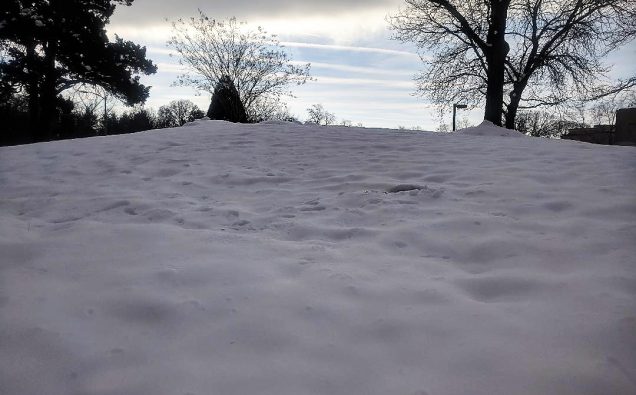
A scene after snowfall in Virginia in January 2019, Photo Views and News
If you are not surprised by the steep plunge in Chicago temperature, look at the sizzling heat in Australia.
While much of North America was in deep freeze, down under, Australia had its warmest January on record with 38% below average rains for January. Adelaide reached a new record high of 46.6°C on January 24.
Both extreme may be linked to global warming or climate change phenomena. They are also linked in raising alarm bells about what might be in store if the planet does not recover from environmental degradation in the near future.
The World Meteorological Office has January “a month of extremes,” with unusually intense weather pictures in different regions of the earth.
The United States is said to be under the the influence of the Polar Vortex that saw the mercury in southern Minnesota experience a windchill minus 65°F (-53.9°C) on 30 January.
“Disturbances in the jet stream and the intrusion of warmer mid-latitude air masses can alter the structure and the dynamics of the Polar Vortex, sending Arctic air south into middle latitudes and bringing warmer air into the Arctic. This is not a new phenomenon, although there is increasing research into how it is being impacted by climate change”, the WMO said.
Wind chills early Wednesday could fall to -55 degrees Fahrenheit in Chicago; the average actual temperature on Mars is -80. https://t.co/PVO9MtDXoD pic.twitter.com/A6s0fg15J8
— CBS Evening News (@CBSEveningNews) January 29, 2019
According to a UN statement, climate sceptics should be careful before equating the frigid conditions, with a rejection of the inexorable rise in global temperatures due to global warming, or rising carbon dioxide emissions:
“The cold weather in the eastern United States certainly does not disprove climate change”, said WMO Secretary-General Petteri Taalas.
“In general, and at global level, there has been a decline in new cold temperature records as a result of global warming. But frigid temperatures and snow will continue to be part of our typical weather patterns in the northern hemisphere winter. We need to distinguish between short-term daily weather and long-term climate’, he added.
Still not all of North America has had record cold temperatures. “While The eastern US and parts of Canada are seeing record-breaking cold temperatures, Alaska and large parts of the Arctic have been warmer than average.”
President Donald Trump cited cold temperatures in the U.S. Midwest as debunking the idea of global warming.
In the beautiful Midwest, windchill temperatures are reaching minus 60 degrees, the coldest ever recorded. In coming days, expected to get even colder. People can’t last outside even for minutes. What the hell is going on with Global Waming? Please come back fast, we need you!
— Donald J. Trump (@realDonaldTrump) January 29, 2019
For people in several other parts of the world, the weather was also intense.
In January, severe winter storms also hit the eastern Mediterranean and parts of the Middle East, severely affecting vulnerable populations lacking adequate shelter, including refugees, the UN says. A cold front in the third week of January that swept south through the Arabian Peninsula, bringing a widespread dust storm from Egypt to Saudi Arabia, Bahrain, Qatar, Iran and the United Arab Emirates, also brought heavy rain and precipitation to Pakistan and northwest India, reports WMO.
Elsewhere, parts of the European Alps saw record snowfalls earlier in January. In Hochfilzen in the Tirol region of Austria, more than 451 centimetres of snow fell in the first 15 days, an event statistically only expected once a century. On Friday, staff at the UN Office in Geneva were advised to leave early due to major whiteout conditions.
In South Asia, the Indian Meteorological Department issued warnings on 21 January of heavy or very heavy rain and snow for Jammu and Kashmir and Himachal Pradesh, prompting warnings of avalanches amid an intense cold front.
In the southern hemisphere, floods and heat hit several parts. Heat records tumbled in Chile. A weather station in the capital Santiago set a new record of 38.3°C on 26 January. In other parts of central Chile, temperatures topped 40°C.
Argentina has also been gripped by a heatwave, prompting a number of alerts about high temperatures. Northeast Argentina, and the adjacent parts of Paraguay, Uruguay and Brazil have been hit with extensive flooding, with well above the long-term expected average rainfall.
The global picture must provoke a reasonable debate on the issue of global warming. Freezing cold in parts of the world does not negate fears of global warming.
“A cold snap in the teeth of global warming is no more unusual than a cool day in summer. Both happen,” said Ben Strauss, CEO and chief scientist at Climate Central, a science education nonprofit, according to NBC News.
“It’s a bit like opening the freezer door — it cools you off if you stand there, but it tells you nothing about whether someone is turning up the room thermostat.
SOURCES CITED IN THE STORY: UN, WMO, NBC NEWS, CBS News, Donald Trump Twitter















[…] Look at the weather extremes. The U.S. is freezing and Australia is sizzling. […]